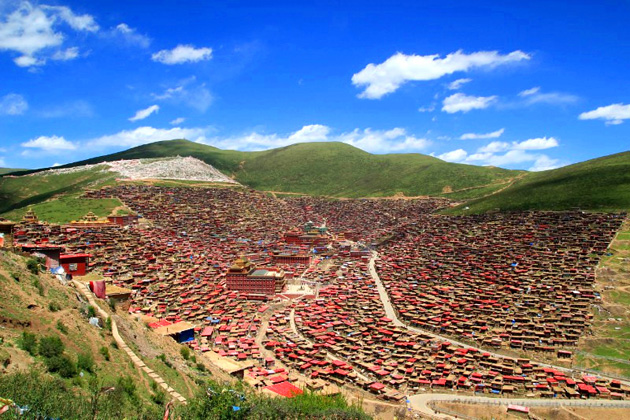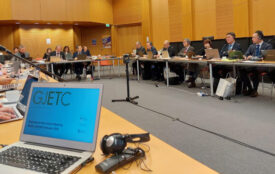China issues demolition order on world’s largest religious town in Tibet
Chinese authorities have announced the destruction of thousands of monastic dwellings and expulsion of monks, nuns and lay practitioners at Serthar Larung Gar Buddhist Institute, the famed Tibetan Buddhist religious encampment located in Serthar (Ch: Seda) County in Kardze (Ch: Ganzi) Tibetan Autonomous Prefecture, Sichuan Province, in eastern Tibet.
An eight-point document issued by the Chinese authorities spells out the step-by-step guide to demolishing housing facilities of thousands of monks, nuns and lay practitioners and their expulsion, so as to reduce the number of residents to government-set ceiling of 5000. Citing the decisions taken at the Sixth Tibet Work Forum Conference and the Second National Work Conference on Religion, the document stated that the demolition order was aimed at proper regulation and management of Larung Gar Buddhist institute. Mainly prefecture-level departments under the direction of mostly Han Chinese officials would carry out the demolition order.In 2001, Chinese authorities implemented similar crackdown on Larung Gar by destroying thousands of monastic dwellings and expulsion of monastic and lay practitioners, some of whom died of shock or resorted to suicide, while some were rendered mentally unsound. Khenpo Jigme Phuntsok, the charismatic founder of Larung Gar Buddhist Institute later died under mysterious circumstances at a Chinese government hospital in Chengdu.
The recent four-page demolition order requires relevant departments including the management and administrative bodies of Larung Gar to reduce the number of residents to 5000 before 30 September 2017. The order further requires that the number of demolished dwellings be equal to the number of expelled monastic or lay practitioners, and to ensure that both numbers are strictly compared and accounted for. The document then calls for clear separation between monastic and lay practitioners and between the monastery and the institute; and implementation of social management and provision of social services within the Larung Gar community.
Seven-point demolition order
The document lists seven points detailing the implementation of the demolition order which involves all religious sections (ling) and units (tsomchung) including also the management and staff at Larung Gar. Religious sections include not only the monks and nuns sections, but also separate sections for lay practitioners and non-Tibetan practitioners such as Chinese. The sections are further divided into hundreds of units as in monastic and lay units. The first point in the document details instructions on guiding the opinions and ideology of both monastic and lay community. In this regard, the order stipulates that decisions taken at the Sixth Tibet Work Forum and the Second National Work Conference on Religion will be publicised among the monks and nuns, and to discuss further about the reasons these changes are required at the monastery, in what manner these changes must be carried out, and how to implement government laws related to these changes, so that religious activities outside the monastery could be managed and regulated. This will be achieved in three steps:
- Larung Gar Standing Committee members, other officials and senior monks and nuns at should be personally contacted and given instruction. All disciplinarians of each monastic section and responsible members of all 18 offices should be assembled and given instruction. Responsible members of all 324 units should be separated into different categories and given instruction. The above work should be completed before15 June 2016.
- All sections and units should be given instruction and monks and nuns must be made to sign letters pledging to practice religion in accordance with the law. Monks and nuns must publicise legal education materials, such as videos and banners. In short, there should be an overwhelming focus on the work to promote law. These works should be completed before 31 July 2016.
- Legal education campaign should be held every month in the monasteries. This campaign should be completed before 31 October 2016. The legal education campaign will be led by Jangchup (Xiang Qu?), Xiang Luo, Dan Nei Kai, Zhang Ping Sen. Departments responsible for this work are the Prefecture Propaganda Department, Prefecture United Front Work Department, Prefecture Religious Affairs Bureau, Prefecture Law and Justice Bureau, and Serthar County Government.
The second point in the demolition order concerns collecting detailed information and conducting research on the residents of the religious sections such as lay practitioners, monks, nuns, elderly and physically challenged. The information collected will be used to register each dwelling of the residents based on specific location and its population, for convenient and thorough investigation. This work must be completed before 31 July 2016. The work will be carried out by Li Jiang, Zhang Ping Sen and Shui Wen and the offices responsible for carrying out this work are: Prefecture Public Security Bureau, Prefecture Civil Affairs Department, Prefecture National Security Department, and Serthar County Government.
The third point in the demolition order provides instructions on reducing the number of monastic and lay practitioners. In 2016, 2200 residents will be made to leave, out of which 1029 lay practitioners will be separated from the monastery. A total of 1200 monks and nuns will be expelled out of which 600 must be from other provinces. In 2016, the total population should be limited to 5000. If it is not done so by 30 September 2017, more should be expelled. Before 15 June 2016, the names of expelled residents in 2016 must be submitted to higher authorities. And before 30 August 2016, the names of the 5000 persons and others, after proper screening, must be submitted to higher authorities. Before 30 October 2016, the expulsion of 1200 residents must be completed. Before 30 September 2017, the population of Larung Gar should be restricted to 5000. Out of them, there should be no more than 1000 people from other provinces. Responsible officials for this work are Zhang Ping Sen, Dan Nei Kai and Cui Yi Peng and responsible departments are Prefecture United Front Work Department, Prefecture Religious Affairs Bureau, Prefecture Education Department, Prefecture Public Security Bureau, Prefecture Civil Affairs Department and Serthar County Government.
In the fourth point, the demolition order details plans to demolish 1500 monastic residences by 30 October 2016. This number includes the residences of those who have been expelled since 2013 and new dwellings built in their stead illegally; residences of those who had left to live in the old people’s homes and of those who went to live in nuns’ guesthouses. The officials responsible for this work are Zhang Yong Dong, Ajie Bei Zhui and responsible offices are Prefecture United Front Work Department, Prefecture Nationality and Religious Affairs, Prefecture Public Security Bureau, Prefecture Village Housing Development Bureau, Prefecture Civil Affairs Department, and Serta County Government.
The fifth point states that surveillance cameras will set up before 31 August 2016 to regulate visitors. Responsible officials for this task are Zhang Ping Sen and Shui Wen and responsible offices are Prefecture Public Security Bureau and Serthar County Government.
The sixth point in the demolition order calls for the separation of lay practitioners from the monastics so that the lay practitioners will come under direct control and monitoring of the government authorities. Before 31 July 2016, the houses built between the monastics and lay practitioners, an area of 30 meters, will be demolished. Before 30 September 2016, walls will be constructed between them. The style and designs of lay practitioners’ residences will be changed. A government office responsible for lay practitioners will be built. Officials responsible for this work are Zhang Ping Sen and Xi Wu. Responsible offices are Prefecture Village Housing Construction Department, Prefecture National Resources Department, Prefecture Civil Affairs Bureau, and Serthar County Government.
The third point in the demolition order provides instructions on reducing the number of monastic and lay practitioners. In 2016, 2200 residents will be made to leave, out of which 1029 lay practitioners will be separated from the monastery. A total of 1200 monks and nuns will be expelled out of which 600 must be from other provinces. In 2016, the total population should be limited to 5000. If it is not done so by 30 September 2017, more should be expelled. Before 15 June 2016, the names of expelled residents in 2016 must be submitted to higher authorities. And before 30 August 2016, the names of the 5000 persons and others, after proper screening, must be submitted to higher authorities. Before 30 October 2016, the expulsion of 1200 residents must be completed. Before 30 September 2017, the population of Larung Gar should be restricted to 5000. Out of them, there should be no more than 1000 people from other provinces. Responsible officials for this work are Zhang Ping Sen, Dan Nei Kai and Cui Yi Peng and responsible departments are Prefecture United Front Work Department, Prefecture Religious Affairs Bureau, Prefecture Education Department, Prefecture Public Security Bureau, Prefecture Civil Affairs Department and Serthar County Government.
In the fourth point, the demolition order details plans to demolish 1500 monastic residences by 30 October 2016. This number includes the residences of those who have been expelled since 2013 and new dwellings built in their stead illegally; residences of those who had left to live in the old people’s homes and of those who went to live in nuns’ guesthouses. The officials responsible for this work are Zhang Yong Dong, Ajie Bei Zhui and responsible offices are Prefecture United Front Work Department, Prefecture Nationality and Religious Affairs, Prefecture Public Security Bureau, Prefecture Village Housing Development Bureau, Prefecture Civil Affairs Department, and Serta County Government.
The fifth point states that surveillance cameras will set up before 31 August 2016 to regulate visitors. Responsible officials for this task are Zhang Ping Sen and Shui Wen and responsible offices are Prefecture Public Security Bureau and Serthar County Government.
The sixth point in the demolition order calls for the separation of lay practitioners from the monastics so that the lay practitioners will come under direct control and monitoring of the government authorities. Before 31 July 2016, the houses built between the monastics and lay practitioners, an area of 30 meters, will be demolished. Before 30 September 2016, walls will be constructed between them. The style and designs of lay practitioners’ residences will be changed. A government office responsible for lay practitioners will be built. Officials responsible for this work are Zhang Ping Sen and Xi Wu. Responsible offices are Prefecture Village Housing Construction Department, Prefecture National Resources Department, Prefecture Civil Affairs Bureau, and Serthar County Government.
Article 36 of the Chinese Constitution not only provides that citizens enjoy freedom of religious belief but forbids any state organ, public organisation or individual from forcing citizens to believe in, or not to believe in, any religion, or to discriminate against citizens who believe in, or do not believe in, any religion. China’s announcement of a second major crackdown on Larung Gar once again renders hollow this constitutional provision.
Tibetan Buddhism with Chinese Characteristics
The basic religious policy of the Chinese Communist Party makes it difficult if not impossible to implement constitutional provisions. In 1993 during the National United Front Work Conference and in 2001 during the National Religious Affairs Conference, the then president Jiang Zemin issued three authoritative directives that sum up the one-party state’s approach to religion: 1) implementation of the party’s religious policies; 2) strengthen control of religious affairs in accordance with the law; and 3) guide religion to be compatible with socialism. At the Second National Work Conference on Religion held in April 2016, president Xi Jinping reiterated the same approach to religious policy stressing that “religious groups must adhere to the leadership of the CPC, and support the socialist system and socialism with Chinese characteristics.”
The Tibetan Centre for Human Rights and Democracy appeals to the international community including the United Nations, governments, civil society groups and individuals to take initiatives to put pressure on Chinese government to rescind the demolition order and to save the Larung Gar Buddhist Institute from further destruction.
This year in May, on the occasion of Saga Dawa (Vesak Buddhist festival), the secretary general of the United Nations Mr. Ban Ki-moon highlighted the role of Buddhism in resolving pressing issues that confront the humanity including human rights abuses and violent conflicts. “The fundamental equality of all people, the imperative to seek justice, and the interdependence of life and the environment are more than abstract concepts for scholars to debate; they are living guidelines for Buddhists and others navigating the path to a better future,” he said.









